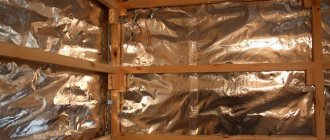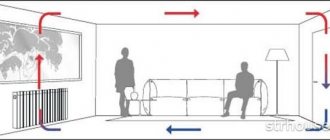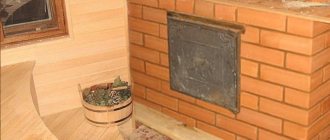There is very little reliable information about the use of foil when decorating a steam room in a bathhouse, which is why myths and disputes about this matter are proliferating on the Internet. Some say that this layer is completely optional. Others hold an even more radical opinion, saying that foil does more harm than good. However, professionals have been using this layer for many years when finishing steam rooms, arguing for its beneficial properties. We propose to understand in more detail why foil is in the bathhouse, and whether it is needed at all.
Should I use foil for a bath?
As you already know, foil is used as insulation for rooms, mainly bathhouses. In most cases, the choice is made towards aluminum foil. The method of application and types of material are quite varied.
Of course, over such a long period of use, the material has acquired both its supporters and opponents.
- Opponents argue that since aluminum has high thermal conductivity, it does not retain heat. Thus, purchasing and equipping your premises with foil is a waste of effort and money.
- It is impossible not to agree with this opinion, except to slightly paraphrase: “Foil will not keep the room warm if you install it, ignoring all the rules!”
Of course, the foil will not show its properties if you attach it to a bare concrete, brick or foam concrete wall. The wall must be reinforced with a layer of insulation. Remember that foil can rebound heat, but not retain it without additional insulation materials.
By using this material you can save money on heating the room, since the foil will retain and accumulate heat in the heated room.
Covering installation
To ensure the most effective and high-quality coating and ensure a comfortable stay in the steam room, you should follow a number of tips when laying the material.
- When laying foil materials in steam rooms of non-commercial baths and saunas, it is sufficient to use rolled or kraft foil with a thickness of at least 3 mm.
- For large steam rooms, foil on a mineral or basalt base is suitable.
- When locating a bathhouse inside a house or in a basement, it is important to take into account central heating and the location of its sources, if possible using it for additional heating of the steam room air.
- Before starting work, it is necessary to provide for the removal of condensate by making a small withdrawal of the canvas from the ceiling to the walls, as well as from the walls to the floor. To do this, the foil material is laid with an overlap of 15-20 cm and taped with foil tape.
Important! To create a “thermos” effect, a gap of 13-18 mm must be left between the layer of foil coating and the finishing to ensure ventilation and maintain a healthy microclimate.
A gap of 1-2 cm will allow the condensate to dry out during the period between heating the bath. Ventilation gap on the ceiling
The installation process of foil occurs in several stages; the most convenient to use are rolls or sheets 60 cm or 1.2 m wide.
- The walls of the steam room need to be lathed with beams with a cross-section of 5x5 cm. The distance between adjacent planks depends on the width of the material.
For rolls of 600 and 1200 mm it is 60 cm, for foil materials with a width of 1000 mm and 1500 mm - 50 cm. The bars are fastened with self-tapping screws of a suitable length. Sheathing Fastening the sheathing beams to the ceiling Fastening the sheathing beams to the floor - A layer of mineral insulation is laid between the slats so that it does not protrude beyond the level of the beams.
Measuring the distance between the sheathing beams. Fastening insulation boards to the ceiling. The photo shows the use of foil insulation. The insulation board is tightly inserted between the sheathing bars. For internal walls, you can use 50 mm thick insulation. For external use, a 100 mm slab is suitable or it is possible to lay 50 mm thick slabs in two layers - A foil material is fixed on top of the insulation layer with the obligatory placement of a reflective layer inside the steam room. The joints of adjacent canvases or sheets can be glued with metal tape, but it should be remembered that under the influence of high temperatures the glue can soften and the panels will separate, breaking the tightness.
Fixing the foil with tape
It is best to fix the foil with staples or nails, nailing them directly onto the beams. If the width is large, the foil material is fixed not only at the edges, but also in the middle.
- The laid foil is sewn up with clapboard, leaving a one and a half centimeter air pocket, the main function of which is to reduce the thermal conductivity properties of the foil layer and to maximize the reflection of all the rays that hit the foil back into the steam room.
An air pocket will allow you to create a sheathing for the lining. Choose planks 10-20 mm thick and fix them with self-tapping screws. Fastening the sheathing under the lining Installation of the lining Cladding wall and ceiling
Sometimes the order of arrangement of materials can be changed - a layer of foil is stuffed onto the insulation layer placed between the sheathing bars, staples or nails, which is fixed on top with thin slats placed strictly on top of the sheathing with self-tapping screws of sufficient length.
Bathroom wall decoration
In some cases, wooden sheathing can be placed on top of the insulation layer, laying foil over the entire area of the walls, including. and on the uneven bars. Then it is impractical to leave air pockets, and the lining is fixed directly on the sheathing. But, as practice shows, purchasing combined heat-insulating materials with a layer of foil is not only more economically profitable, but also significantly simplifies the entire installation process.
Fastening the sheathing to aerated concrete walls It is correct to attach the block to the concrete walls through spacers 2-3 mm thick in order to leave a ventilation gap. We align the bars according to the level. For fastening self-tapping screws to walls made of aerated concrete, ordinary nylon dowels No. 6 are suitable. Water supply pipes pass under the clapboard sheathing. When installing the sheathing avoid contact with the floor The deviation from the unprotected steel chimney when passing through the ceiling must be at least 50 cm Installation of foil on top of the insulation Fastening the lining
Video - How to properly decorate a steam room in a bathhouse
Arranging steam rooms using foil materials allows you to save 25-30% on heating raw materials for stoves, as well as extend the service life of the structure, preventing the development of fungi, mold and microorganisms harmful to humans.
How to choose the right foil for a bath
Please note that purchased foil may not always fit well on certain surfaces, because of this you must know what little details you need to pay attention to and what criteria to use when choosing.
It must be said that the choice of material should be based on what kind of surface you have and the fastening method you choose.
Let's consider the basic criteria by which you can make a choice:
- Price - pay attention to this, since inexpensive options are most often not of good quality at all, but expensive ones often are. Therefore, to ensure that the foil is of high quality, choose a brand that is manufactured by one of the market leaders.
- Purpose is the most important criterion due to the fact that each material has its own type of foil. Of course, it is allowed to apply foil to any surface, but the service life will be significantly reduced.
- Foil on the crate is the most recommended option. The likelihood of damage to the foil in this case is significantly reduced.
- Environmentally friendly - choose only clean, natural rolls of foil that are not capable of releasing toxic substances when heated.
- Vapor permeability – no higher than 0.01 g/m² per day.
Which foil manufacturer can you trust?
There are a sufficient number of brands on the building materials market that specialize in the production of foil insulation. Among all, three manufacturers can be distinguished.
- Izolon . The concern is located in Izhevsk. Specializes in the production of foil and plastic. Special technologies are used to produce insulation. The material is available in stitched and unstitched form.
- Penofol . This manufacturer produces thin material with no backing. At the same time, the structure is quite strong and reliable.
- URSA . One of the leading manufacturers in Spain. It produces high-quality insulation materials of various thicknesses and structures. This insulator is also sold in Russia.
When choosing a brand, attention is paid to those brands that promise high quality and compliance with all GOSTs.
The remains of the foil sheet can be used in places where the thermal insulation is damaged PHOTO: klevo.net
Foil without base
Quite thin material. This foil is used to insulate walls in warm rooms (mainly baths). It must be installed on a previously installed insulation layer.
The ends of the material are overlapped one on one, and the joint of the sheets is certainly glued using adhesive tape on a metallized base. This way you will create a completely sealed reflective layer of foil.
The limit of the reached temperature is +650°C. That is, foil can provide rapid heating of the room and maintain its temperature for a long time.
Foil without a base is considered resistant to damage and is not capable of releasing dangerous toxic elements when heated.
Advantages and disadvantages of the material
Foil usually always comes complete with another type of insulation. It is rational to install it in combination with glass wool and other denser materials. If these conditions are met, the material will have the following advantages:
- Vapor barrier and thermal insulation - thanks to this, hot steam does not pass into the middle of the insulating material, thereby preserving its properties, as well as the heat inside the room.
- Fire safety . The material can withstand high temperatures and is not flammable. Prevents fire from spreading to other walls.
- Possessing good soundproofing properties . Suppresses noise from the street and inside the steam room by almost 70%.
- Reducing the heating time of the bath . Thanks to properly equipped insulation of the internal walls, heat will quickly fill the steam room and be retained in it.
It is better to paste only with special tape. Ordinary tape will not withstand the weight of insulation PHOTO: potolok-exp.ru
Scheme of thermal insulation with foil in a bathhouse made of timber PHOTO: v-banyu.ru
Despite the large number of advantages, this material is not without disadvantages. These include:
- constant formation of condensation;
- you can’t do without ventilation equipment;
- air does not penetrate well, which can cause dampness and mold;
- poisonous properties of aluminum (this metal can glow in the body).
Proper care of the room and regular ventilation can reduce all the disadvantages to a minimum. Therefore, after each bath, you should not forget to open doors, windows and vents.
When insulating the ceiling, they try to use individual technology PHOTO: deluxemm.ru
Kraft foil
This type of material is produced on a paper basis. Comprises:
- Foil,
- Kraft paper,
- Polyethylene.
This material is quite durable, so you don't have to worry about it tearing while layering. Another distinctive feature is that it can be used without adding insulation.
- Moreover, foil based on craft paper is considered natural, that is, when heated, it also does not emit toxic substances and is considered safe for humans.
- Thickness: 0.03mm-1.0mm.
- Temperatures can reach one hundred degrees.
The ends of the material are overlapped one on one, and the joint of the sheets is certainly glued using adhesive tape on a metallized base.
This material is more convenient to use due to its base and increased strength properties.
Tips for installing foil
It is clear how to attach foil to the walls of the steam room. However, do not neglect the following tips.
- To install insulation, it is necessary to install a separate sheathing.
- Sufficiently thick foil sheets are best glued joint to joint using aluminum tape.
- Damaged canvases must be sealed with the same tape.
- Insulation and sheathing cannot be done closely. It is important to leave a distance between materials of at least 3 cm.
- The insulation near the windows must be measured closely, and after installation it must be covered with sealing tape around the perimeter of the frame.
For ceilings it is better to use super-strong foil material PHOTO: kakpotolok.ru
Soft material is installed on the prepared sheathing PHOTO: uteplix.com
Foil fixed with slats with insulation PHOTO: kubankrovmontag.ru
Follow the installation requirements and be guided by the performance characteristics of the material when using it. Also ask questions about the topic of publication and do not forget to rate the article.
Folgoizolon
This foil is polyethylene foam with foil as a cover.
- You can find it in stores in roll or sheet form. Depending on what thickness of the product you personally need.
- The product has high strength, shock absorption and sound insulation characteristics.
- This fact means that it can be laid on the surface without additional insulation.
- Most often it is used as insulation for wooden surfaces.
It is also worth noting that the material cannot be deformed.
The principle of operation of foil insulation
The walls in the bathhouse are insulated with foil to preserve heat.
The insulator is based on a layer of foamed polymer particles, on which a foil coating is applied. The polished aluminum layer has a reflective coefficient of 97%; it is glued using high-temperature welding.
Thermal insulating qualities are based on the effects:
- insulation of walls from internal vapor;
- reflection of energy into the room.
Folgoizol easily absorbs noise, so it is often used for sound insulation. The rule that allows the insulator to reduce heat loss is to place the layer with the shiny metal side inside the steam room.
The material is not overlapped, but aluminum construction tape is used for joining. There should be a small ventilated gap between the finish and the insulation to reduce heat transfer through adjacent hard surfaces.
One layer of penofol will not provide the required insulation efficiency. The material is used separately to reflect infrared rays or mounted in combination with traditional insulation. Thin foil insulation allows you to reduce the thickness of the insulating layer. Foiled polystyrene foam is used inside and outside the bath.
PIR boards
These slabs are ideal for insulating saunas and baths. The inside of the slabs is porous, but the cells inside are closed, which is why they do not absorb water.
- This is the most important indicator that you should pay attention to when choosing insulation for baths and saunas, where humidity will always be present.
- The stove is able to withstand large temperature changes without emitting toxic substances. PIR boards are used to insulate various surfaces: walls, ceilings or floors.
There are many types of slab coatings, but aluminum foil is the most popular.
This type of insulation is a strong barrier not only to heat, but also to vapors emanating from water. In addition, you can save on heating the room. By heating it once, you will not have to frequently add firewood to the stove or increase the heating time of the boiler.
Foil layer for a bath: its functions and features
Would-be builders have always believed that foil is of no use when arranging a bathhouse. However, this opinion is wrong, and with the right approach to its installation, you can achieve a special effect.
Foil material can have a different structure: smooth or ribbed PHOTO: bani.io.ua
In fact, foil is a thin layer of aluminum. When mounting it on the walls under wooden cladding, all the heat that the boiler produces reaches the surface and is reflected back. Thus, all thermal energy remains in the room. This layer is used together with insulation or separately. The corresponding material is capable of reflecting about 97% of the heat generated by the furnace.
When purchasing foil for a bath, you must ensure that the foil is intact, without perforation PHOTO: skif53.ru
Related article:
Finishing the bathhouse inside. Photos and examples. In a separate publication you will find interesting ideas for decorating steam rooms and relaxation rooms, and also learn the main stages of installation.
Photo of foil for a bath
Product range of possible foil insulating products
Knowing the basic requirements for foil materials, you should consider in detail the types of thermal insulation products. Finishing a bathhouse with foil will take less time if you study all the diversity of the insulation market in advance. Below is a list of the most common ones:
- Aluminum foil for the bath. This thermal insulation product is sold in rolls. Rolls in the markets are presented in a wide range. Rolls can be of different widths and lengths. The thickness of the layer can also be different.
Foil in rolls does not have a base. Used for installation on top of an existing mineral insulator. You can use aluminum foil for a bath up to 650 degrees. The owner himself can choose the thickness of the thermal insulation; it is important to remember that the final strength depends on this. The reflectivity of aluminum sheeting is usually at least 95%.
Installation is carried out with an overlap, with mandatory gluing of the joints with metallized tape. The use of foil for insulation is absolutely safe for human health, since it does not emit toxic substances when heated.
- Kraft foil. This thermal insulation material is made on the basis of cellulose; it can also be found in a three-layer design consisting of foil, polyethylene and kraft paper.
The main properties include high strength, environmental friendliness, and tightness. Kraft foil has a small thickness, which may not exceed 1mm. The surface of the foil has a reflectivity of 95%. Despite the fact that the operating temperature of kraft foil is noticeably lower than that of rolled aluminum sheets, and is only 100 degrees, it is much more convenient to install, since it is less susceptible to mechanical damage and has greater flexibility.
- "Folgoizolon". Baths whose walls are lined with this material, if all technology requirements are met, do not require additional insulation measures. In addition to all the main functions, Folgoizolon has soundproofing properties. This product is usually sold in rolls, but you can also find sheet packaging when it is thick. Its base is foamed polyethylene.
How to sheathe it correctly?
The main condition for installation is an overlap fastening with an overlap of 10-20 cm, the joints should be taped with special tape, then there will be no loopholes for steam, condensation will fall to the floor without penetrating the insulation layer.
Aluminum tape – guarantee of tightness
The use of foil in a log bathhouse differs from the technology for insulating a building made of brick and concrete. Walls made of logs should be carefully caulked. If the tree looks aesthetically pleasing, the log house is of high quality, and the rooms (except for the steam room) are not intended to be covered with clapboard, then there is no need to use foil for the walls. The ceiling is sheathed with a heat reflector without fail.
On a note! To get the effect of a thermos, it is necessary to cover the steam room with foil, the walls, floor, and ceiling.
Work on the floor is carried out after the lining is sewn onto the ceiling and walls, the correct installation of which requires the presence of a gap between the frame and the heat reflector layer.
An air gap is required
The same procedure for installing a foil-coated layer of brick-concrete buildings. With the difference that all rooms (walls, floors and ceilings) are sheathed there, without exception.
On a note! Particular care should be taken to upholster the junctions with window and door openings. Nail the foil with tape, glue it with tape, checking for the absence of cracks.
Proper window covering
In conclusion, a few words about ideal insulation. Foil materials act as a heat reflector without actually being insulation. For high-quality insulation, it is necessary to install a cake, the top layer of which is a vapor barrier material, then the insulation itself, and only then a layer of foil material. In this form, the bathhouse will be functional, healthy, and pleasant for the soul and body.
Principles of insulation depending on the type of building
The choice of insulation depends on the material from which the bathhouse is built. We need to talk about each type of building in more detail.
Made of brick
Sheathing with foil and clapboard is usually done in brick baths. Carrying out work:
- Without additional insulation of walls, ceilings, and in brick baths, it is impossible to achieve an optimal level of comfort.
- All brick surfaces are covered with foil. The individual sheets are glued together with metal tape.
- The sheathing needs to be secured over the reflective sheets. It must be independent so that there is good ventilation between the wooden frame and the foil layer.
If there is no ventilation, condensation will accumulate inside, which will cause the wooden frame to rot.
Made from concrete
To insulate concrete surfaces, ordinary foil will not work. You need to choose a material that has a backing. It is fixed on top of the waterproofing layer.
Made of wood
It is not necessary to cover wooden beams with foil. To achieve an optimal level of comfort, it is enough to correctly caulk the seams between the logs. You can cover the ceiling in the steam room with foil. It needs to be secured with the reflective layer down, the sheets overlapped, and glued with aluminum tape.
Finishing
The insulation for the walls inside the bathhouse with foil cannot be left uncovered. Foil has low strength. In addition, the material can never be installed without a single wrinkle, so this coating looks very mediocre. To eliminate this, a fine finish is applied.
For bathhouses this is traditionally wood. In front finishing it is used in the form of lining (thin board) or block house (thick board with imitation of a log house or timber). Foil under the lining in the bathhouse is an economical and practical solution. The fastening of the front trim is adhesive and with self-tapping screws, which are recessed and sealed with wooden plugs.
Methods for attaching panels to walls
Using nails or self-tapping screws is the traditional option for attaching panels to walls. A more modern method is the use of clamps. It does not damage the panels, but requires additional costs of both time and money when installing the lining.
Using nails or screws
This method will require a screwdriver or hammer, as well as special nails or self-tapping screws - galvanized or made of copper alloy. Such fittings are more expensive, but if you save on them and buy ordinary nails, they will begin to rust over time. This will lead to the appearance of red streaks on the lining, which will spoil the appearance of the finish and stain the skin and things when touched. The fasteners are driven or screwed into the lining tenon at an angle of 45 degrees. The fastening points will have to be sanded so that there are no burrs or other defects left. The disadvantage of this method is that holes will have to be created on the planks when fastening them with nails. And when you try to remove the lining, the fastening points will be further damaged, which precludes the reuse of the panels if necessary.
Fastening with clamps
Do-it-yourself installation using clamps is safe for lining strips because it does not damage them. A clamp is a special bracket that is attached to the lower half of the lining groove - a recess into which the tenon of the next plank is inserted. The fastenings of the bracket are covered with the next strip in the row. Fixing the staples to the sheathing beams is carried out with nails or self-tapping screws.
With this installation method, the lining is not damaged, and there are no nail heads or screws left on the outer surface of the cladding, which eliminates the risk of getting burned or getting a rusty drip on your clothes after visiting such a bathhouse.
It is also easier to partially replace the lining mounted in this way - just pull the boards out of the grooves and pull out the fasteners. If you do not work carefully, it will be the staples that are damaged, not the boards.
We recommend reading:
How to make a ceiling in a bathhouse











